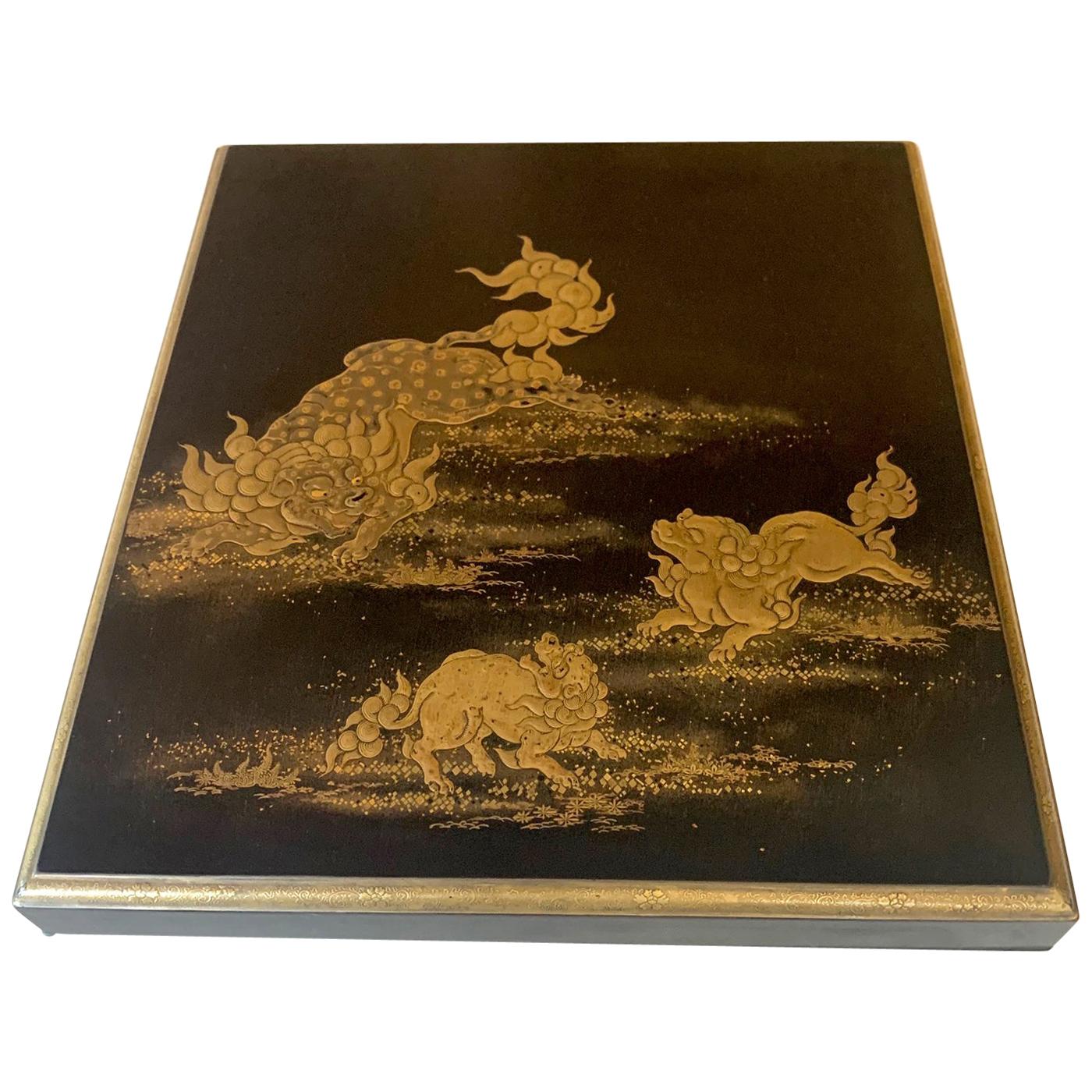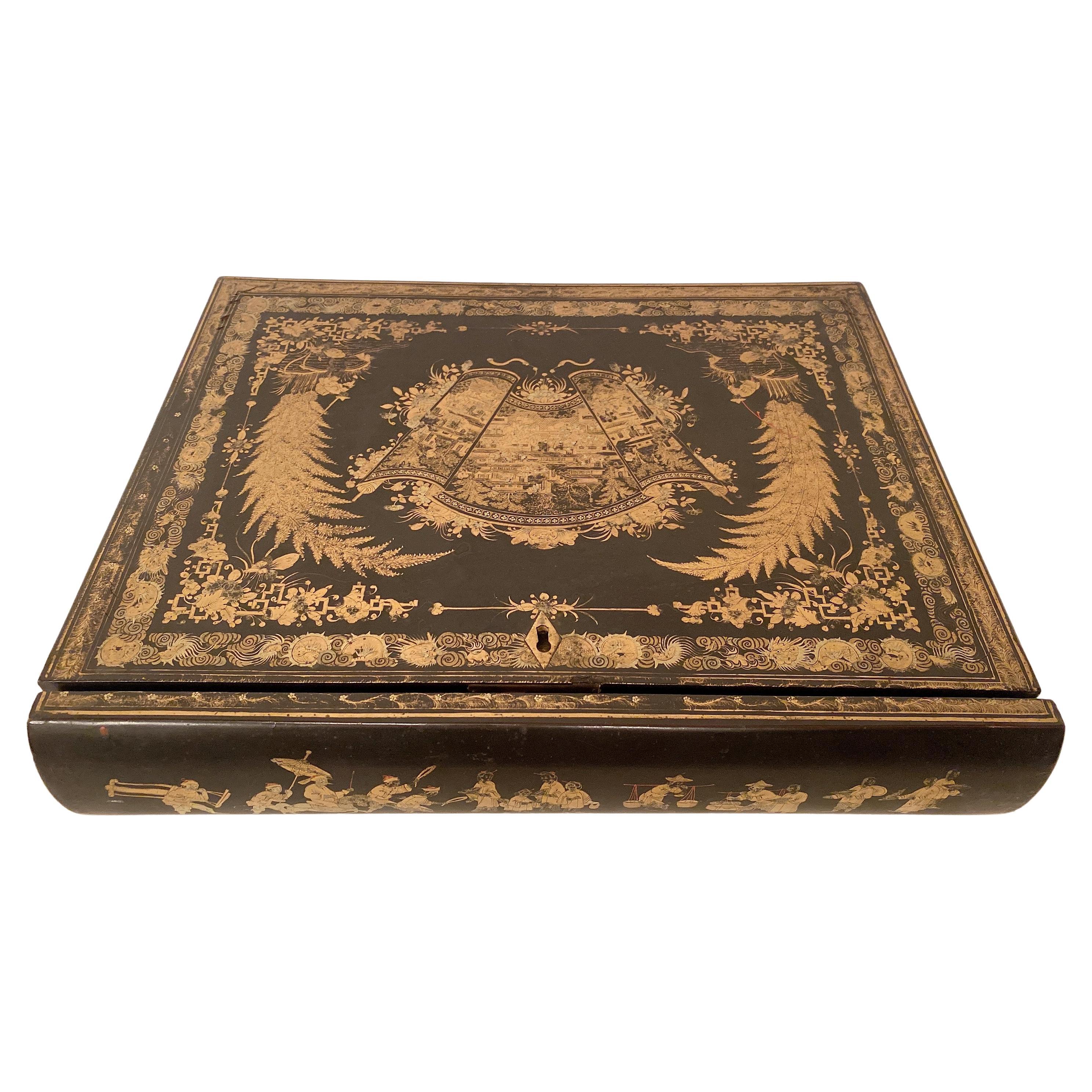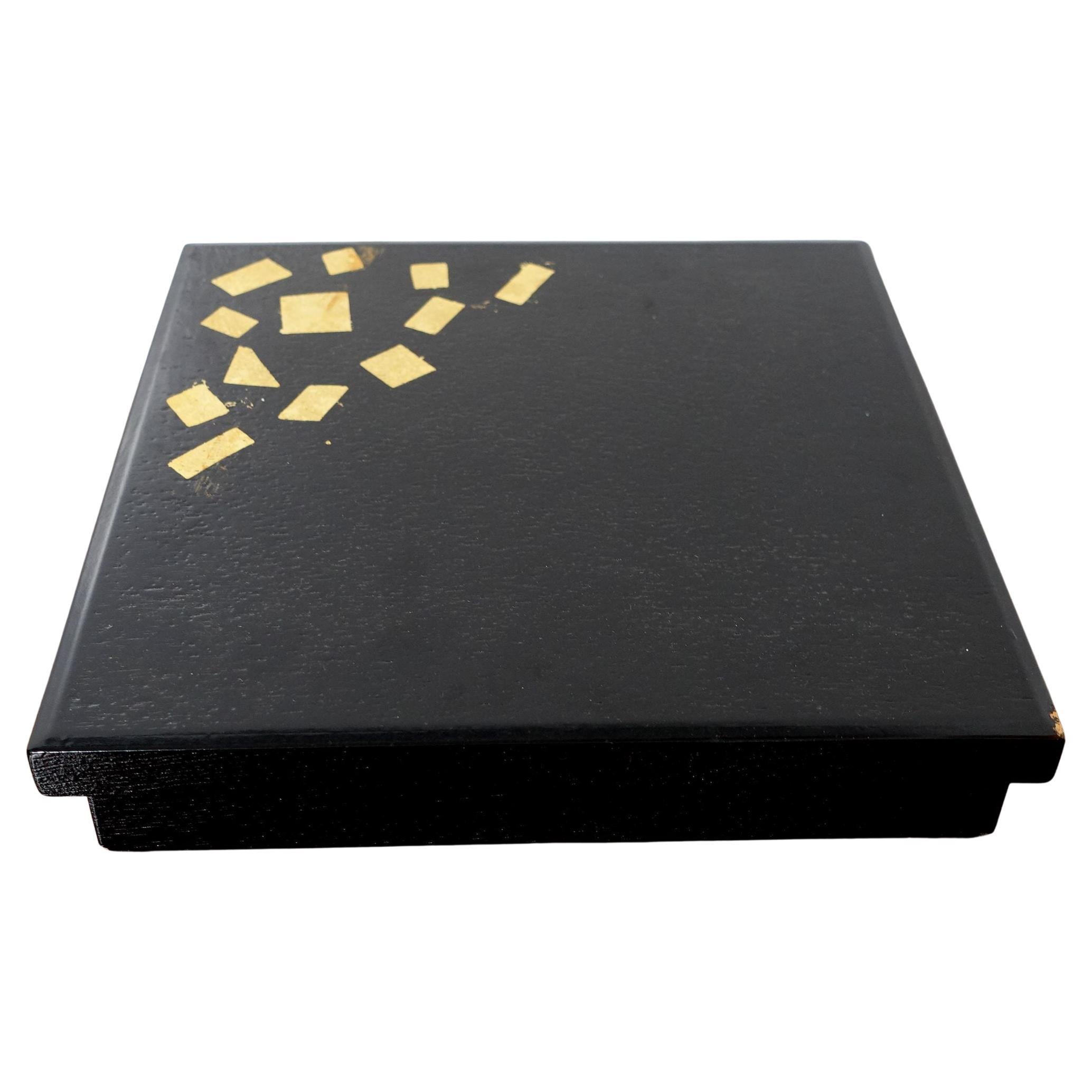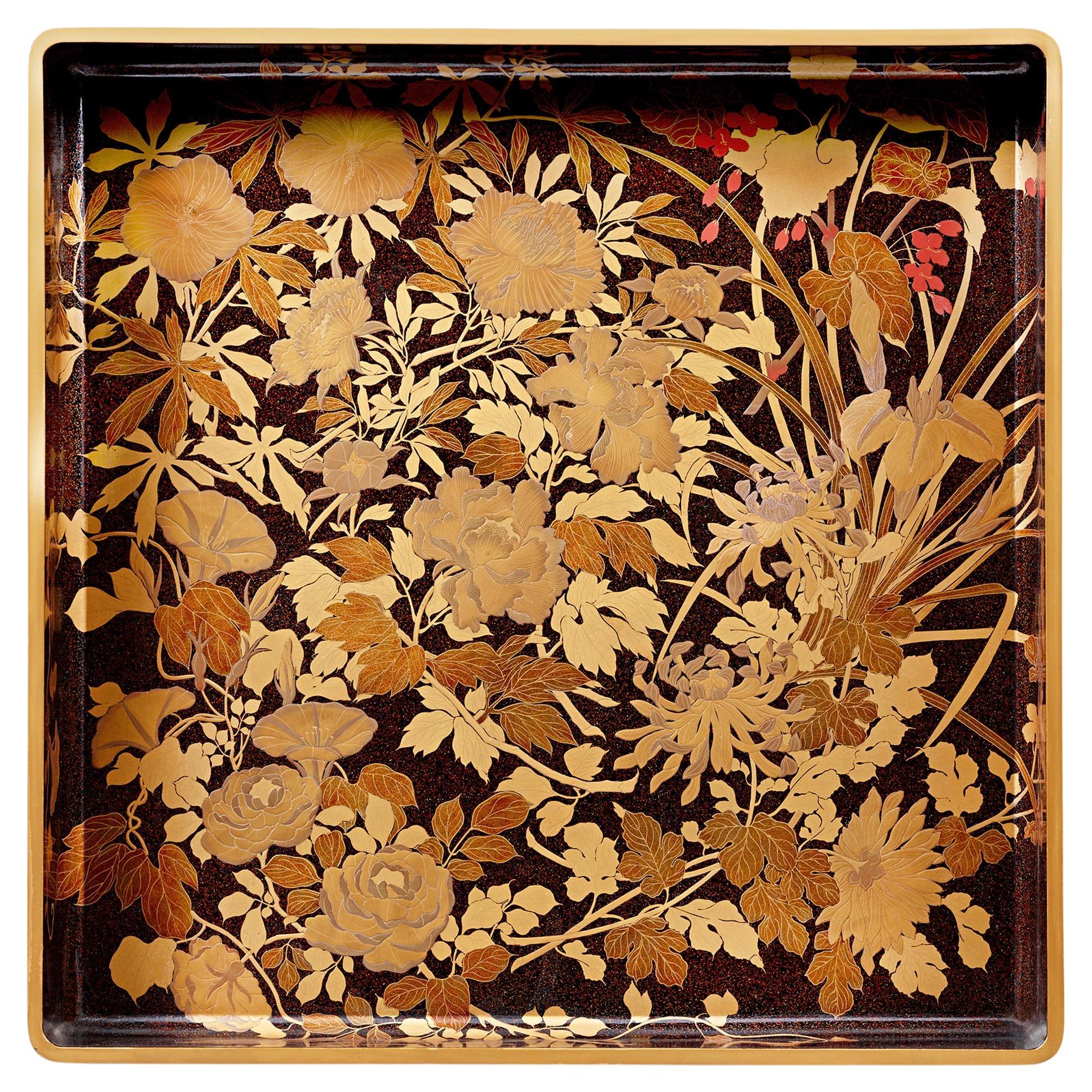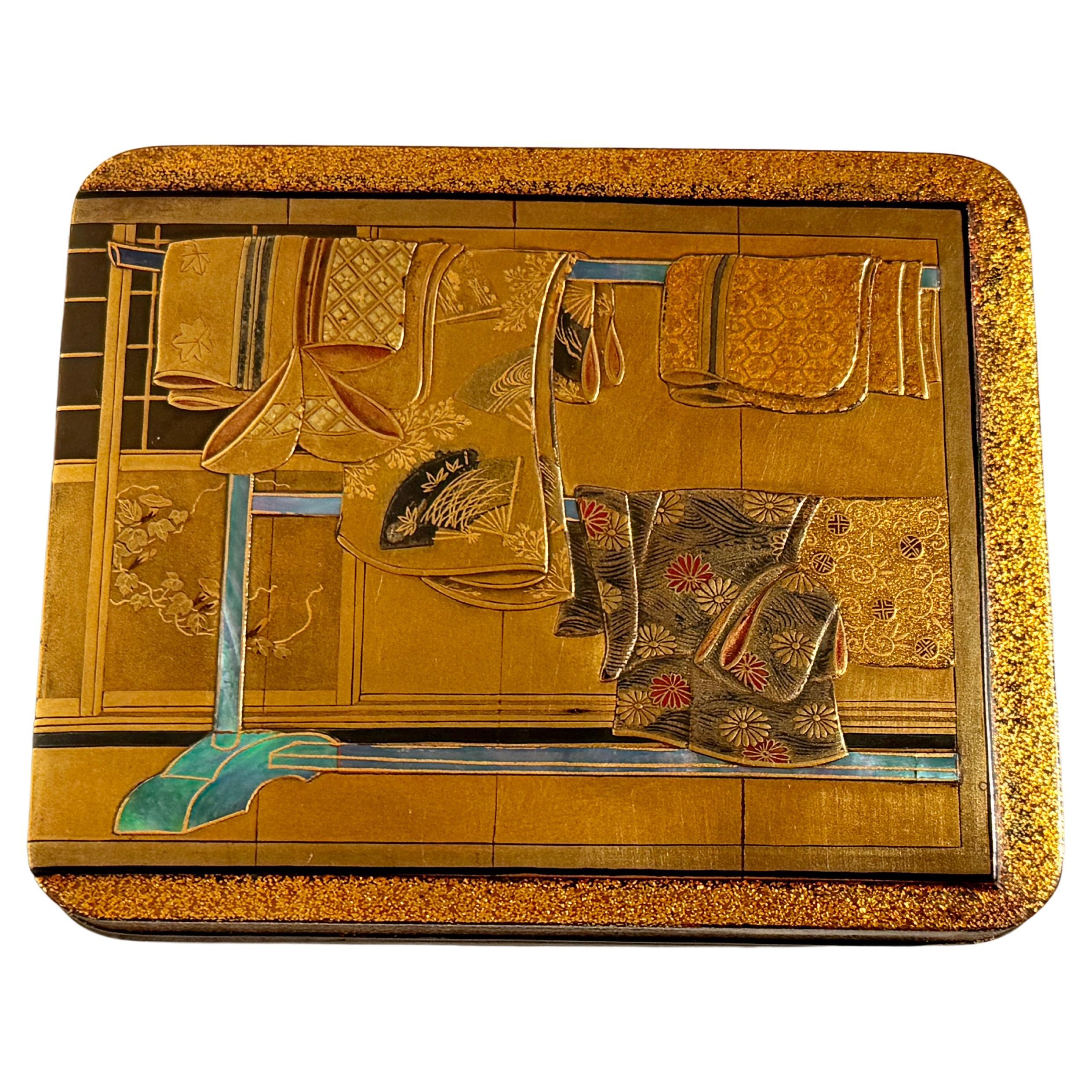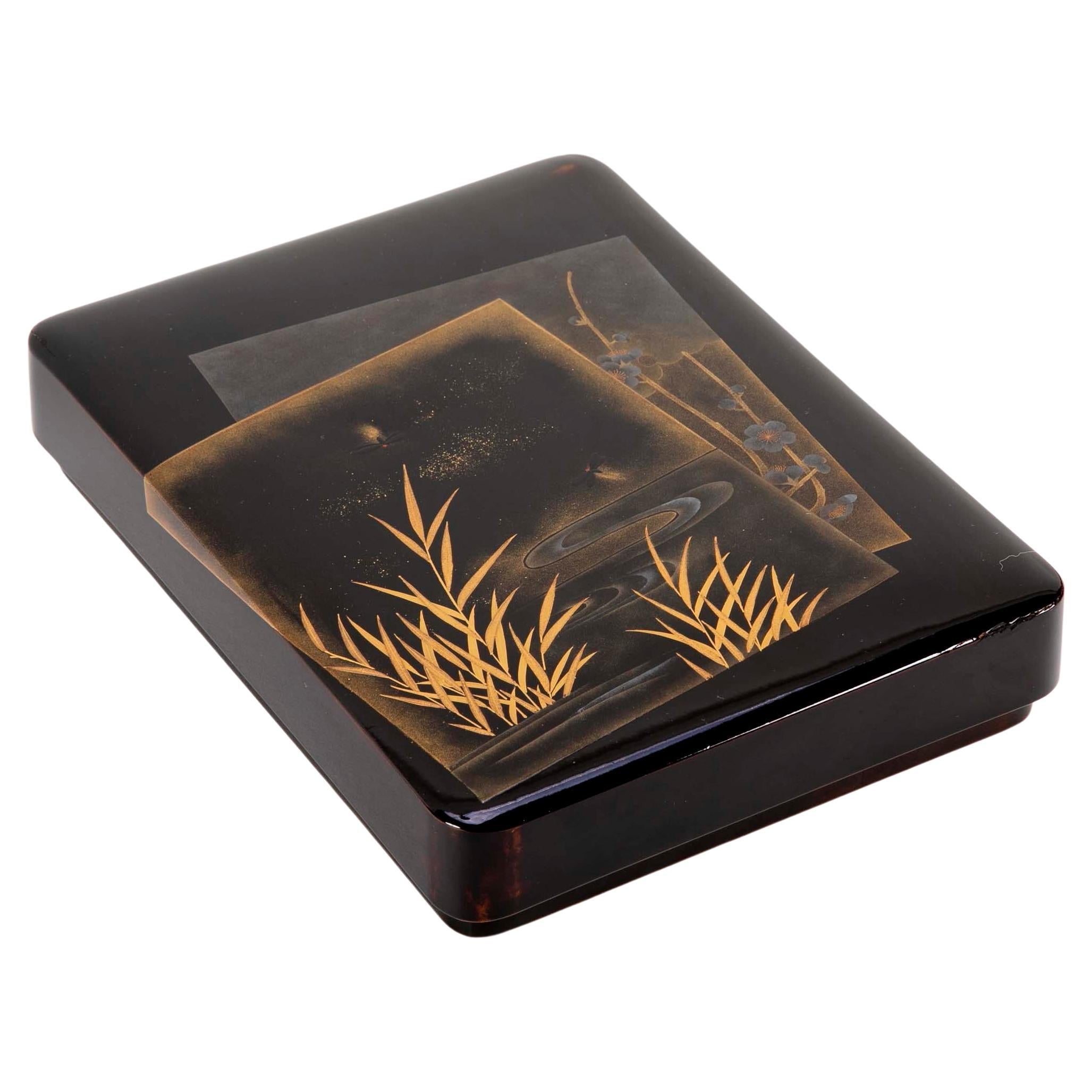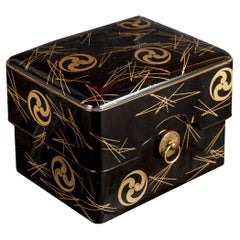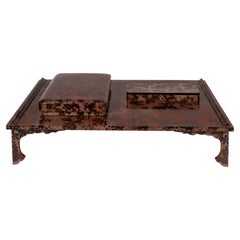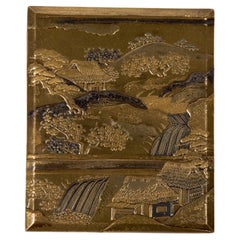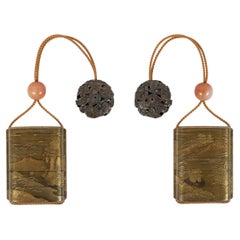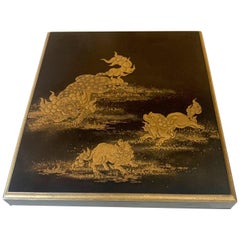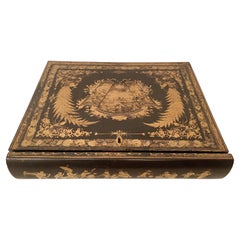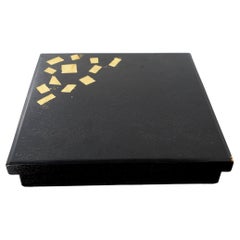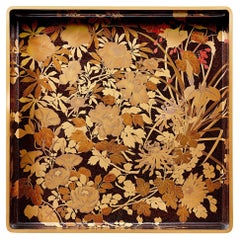Items Similar to Black and Gold Lacquer Suzuribako 'Writing Set'
Want more images or videos?
Request additional images or videos from the seller
1 of 8
Black and Gold Lacquer Suzuribako 'Writing Set'
$23,962.87
£17,835.49
€20,000
CA$32,823.14
A$36,506.50
CHF 19,062.56
MX$444,245.28
NOK 243,457.98
SEK 228,320.64
DKK 152,253.02
Shipping
Retrieving quote...The 1stDibs Promise:
Authenticity Guarantee,
Money-Back Guarantee,
24-Hour Cancellation
About the Item
Black and gold lacquer suzuribako (writing set) in takamaki-e on a nashi-ji background representing two tigers near rocks, bamboos and plum blossoms in a night landscape. Inside of the lid with a lake landscape.
The interior of the suzuribako is composed with an inkstone, topped by a copper water bucket in the shape of a chrysanthemum on the left side, with a brush and a small knife. It includes in the right part a storage compartment.
Inscription under the inkstone "Inkstone made by Nakamura Chobe".
Although the tiger is not native to Japan, it has a high symbolic. The figure of courage was introduced by Buddhism from China. According to the Chinese tradition, the tiger is from one of the stars of the Great Bear. It would be able to control the wind and its roar would be a metaphor for thunder.
In art, the tiger is sometimes represented in a bamboo grove, as it is the case on our suzuribako. There are several explanations for the combination. Bamboo is not wind resistant, si it is a naturel refuge for the animal. Another explanation is that the bamboo is agitated by the wind and represents sins. To be able to penetrate it and thus ward off evil, one must have the strength of a tiger. Having the “tiger courage” is therefore an exemplary quality, especially for samurais.
Inkstone made by Nakamura Chobe
Japan – Edo period (1603-1868), Mid-18th Century
Measures: Height: 1.97 in. (5 cm) – width: 8.58 in. (21.8 cm) – depth: 9.53 in. (24.2 cm).
- Dimensions:Height: 1.97 in (5 cm)Width: 8.59 in (21.8 cm)Depth: 9.53 in (24.2 cm)
- Materials and Techniques:
- Place of Origin:
- Period:
- Date of Manufacture:1603-1868
- Condition:Wear consistent with age and use.
- Seller Location:PARIS, FR
- Reference Number:Seller: 2022-10721stDibs: LU8311233526122
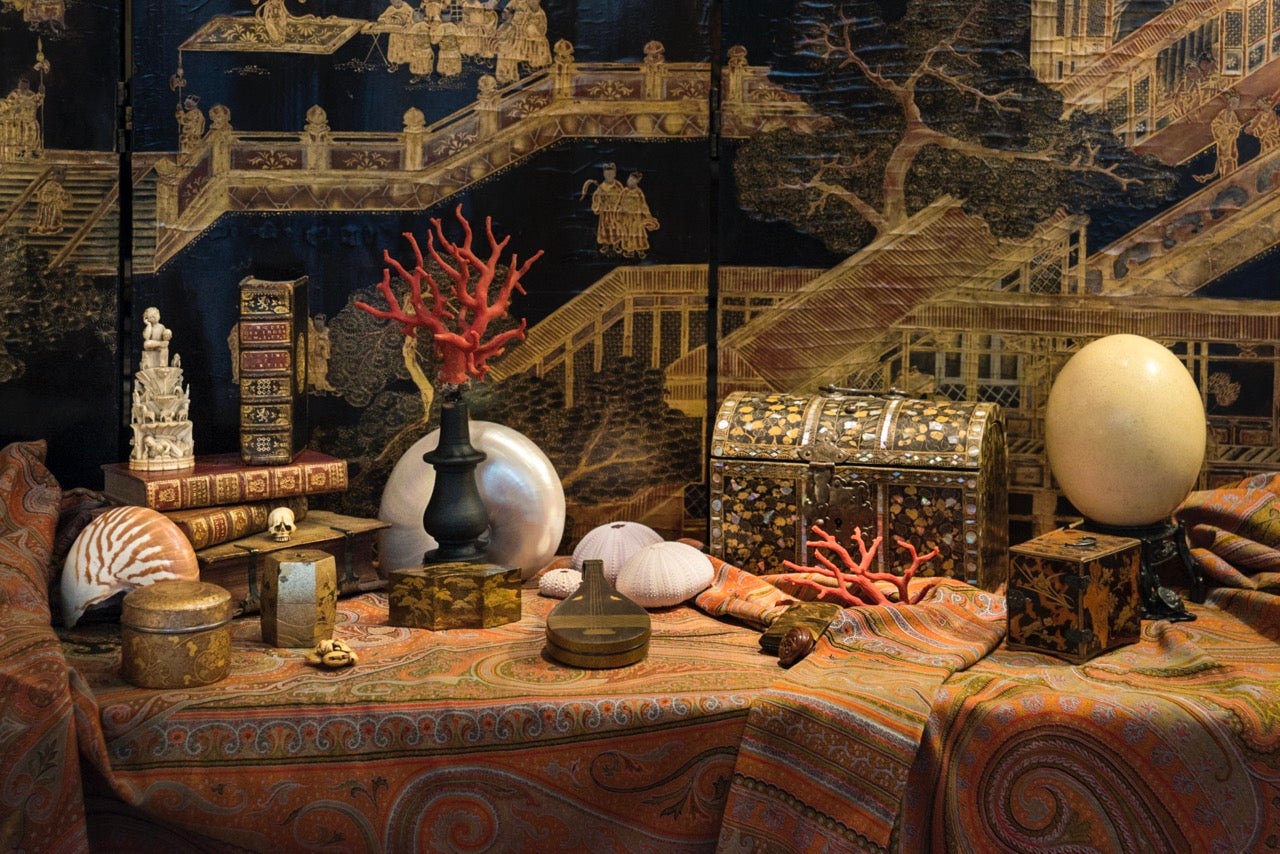
About the Seller
No Reviews Yet
Vetted Professional Seller
Every seller passes strict standards for authenticity and reliability
Established in 2013
1stDibs seller since 2023
Typical response time: Several days
- ShippingRetrieving quote...Shipping from: PARIS, France
- Return Policy
Authenticity Guarantee
In the unlikely event there’s an issue with an item’s authenticity, contact us within 1 year for a full refund. DetailsMoney-Back Guarantee
If your item is not as described, is damaged in transit, or does not arrive, contact us within 7 days for a full refund. Details24-Hour Cancellation
You have a 24-hour grace period in which to reconsider your purchase, with no questions asked.Vetted Professional Sellers
Our world-class sellers must adhere to strict standards for service and quality, maintaining the integrity of our listings.Price-Match Guarantee
If you find that a seller listed the same item for a lower price elsewhere, we’ll match it.Trusted Global Delivery
Our best-in-class carrier network provides specialized shipping options worldwide, including custom delivery.More From This Seller
View AllJapanese Black and Gold Lacquer Kushibako
Located in PARIS, FR
Kushibako (comb box) in black lacquer with gold lacquer decoration of arrows and my in the shape of three assembled commas " mitsudomoe " (Okabe; Itakura; Kuki; Hijikata; Arima famil...
Category
Antique Late 19th Century Japanese Lacquer
Materials
Lacquer
Japanese writting set in waqasa lacquer including bundai ryoshibako and fudebako
Located in PARIS, FR
Set of bundai, ryōshibako and fudebako in wakasa lacquer with an old rose background and black traditional Japanese patterns.
The saya pattern (or sayagata) is composed by Chinese svastikas. This symbol linked to Buddhism, mean intelligence, power and peace. It is a good omen sign.
The kanoko pattern reminds stains on fawn back.
The sakura (cherry blossom) pattern is emblematic of Japan. The blossoming in a short time marks spring beginning and is a symbol of renewal and ephemeral beauty.
There are also traces of calligraphy brush, in reference to the function of the objects.
Bundai is a low table used to put books or scrolls and, later, to write.
Rectangular ryōshibako (letter and document box) with a slightly domed
Fudebako (pencil case) of rectangular format very narrow in its length with two rounded corners, flat cover.
Wakasa lacquerware...
Category
Early 20th Century Japanese Taisho Lacquer
Materials
Lacquer
Japan lake landscape kobako box lacquer - Edo
Located in PARIS, FR
Rectangular kobako box in takamaki-e and kirigane gold lacquer circled with pewter depicting a lake landscape. Inside and back of the box in nashi-ji lacquer.
Japan – Edo period (16...
Category
Antique 18th Century Japanese Lacquer
Materials
Gold
Gold Lacquer Inro Decorated with a Lake Landscape
Located in PARIS, FR
Inro with four gold lacquer boxes, decorated with a lake landscape. Accompanied by a bronze ryusa manju.
Small boxes formed of compartments that fit one on top of the other, inro (? ?) are traditional Japanese clothing...
Category
Antique Mid-19th Century Lacquer
Materials
Lacquer
Fine Japanese Black and Gold Lacquer Sageju-Bako - Picnic Box
Located in PARIS, FR
Black and gold lacquer sageju-bako (picnic box) decorated with floral motifs in hiramaki-e. It includes a sake bottle, a four-compartment box with nashi-ji lacquer inside, a simple tray and a hollow tray. At the top, there is a bronze handle for transport.
The sageju-bako is divided into four superimposed boxes for food on the left; a simple tray, a sake bottle and a hollow tray on the right. They are in the shape of a plum blossom.
On the top, on both sides a phoenix. The phoenix (hôo) has an imperial and solar symbolism. This auspicious bird also embodies virtues taken from the teachings of Confucius (such as goodness, righteousness and wisdom).
The left boxes are patterned with turtles, plum tree, bamboo, cherry blossoms, water plantains near rivers. The two trays on the right have a shell and seaweed pattern. The sake bottle is decorated with a plum tree and bamboo.
On the sides, calabash decoration. Borders in saya (or sayagata) pattern, composed of Chinese swastikas...
Category
Antique Early 19th Century Japanese Lacquer
Materials
Lacquer
Japanese Bundai or writting table in gold lacquer with a decor of lake landscape
Located in PARIS, FR
Rectangular bundai writing table on four legs in gold lacquer with black highlights on a nashi-ji background. The top is decorated with a lake landscape with plum trees, pine trees a...
Category
Antique Early 18th Century Japanese Edo Lacquer
Materials
Gold, Bronze
You May Also Like
Japanese Lacquer Box with Fine Maki-e Decoration Meiji Period
Located in Atlanta, GA
A lacquered wood box with lid from Japan circa 19th century Meiji Period. The finely decorated box was used to store paper slips and small documents on the desk. It is overall finished with black lacquer (kuro) with sparse Mura-Nashiji effect outside and on the top surface of the lid, there are three Komainu, (sometimes known as Shishi or Japanese lions) frolicking and forming a circle in lively motion. Komainu are auspicious animals in Japanese cultures in both Shinto and Buddhism tradition. Originally from China, these animals symbolizes guardians to ward off evil spirits. Hiramaki-e was used in combination with carving and combing to render the lions with various surface textures. A gilt border with an slight angle was given to the lid and even the thin band is decorated with miniature floral scrolls. The interior of the box was finished in a dense nashiji. Underneath the lid, a cluster of peonies open lavishly by two gentle mounts. Takamaki-e (high relief) in both gold and silver were...
Category
Antique Late 19th Century Japanese Japonisme Lacquer
Materials
Wood, Lacquer
Rare Early 19th Century Chinese Gilt Black Lacquer Writing Box
Located in Brea, CA
A truly rare beautiful and amazing piece. From the early 19th century of the Qing Dynasty in China, this gilt black lacquered writing box is ...
Category
Antique Early 19th Century Chinese Qing Lacquer
Materials
Lacquer
Japanese late Meiji period Large Organizer Lacquered Box, Ric.053
Located in Norton, MA
Japan, late Meiji period or later, a large black square organizer box and cover, decorated with geometric squares in gold on the cover
Category
Antique 19th Century Japanese Decorative Boxes
Materials
Lacquer
Japanese Lacquer and Gold Tray
Located in New Orleans, LA
This Meiji-period lacquer tray represents the mastery of Japanese craftsmen in the art of lacquer work. Precious materials are precisely inlaid in the lacquer base, creating a highly...
Category
Antique Late 19th Century Asian Meiji Lacquer
Materials
Gold
Japanese Tagasode (Whose Sleeves?) Lacquer Incense Box, Kobako, Meiji Period
Located in Austin, TX
A fine and unusual Japanese lacquer box for incense accessories, kobako, featuring a tagasode (whose sleeves?) design, Meiji Period, circa 1900, Japan.
The exquisite box of simple rectangular shape worked in maki-e lacquer, taka-maki-e, and raden, all against a lush ground of gold nashiji. Fitted with silver rims.
The main decorative element of the box depicts a six panel folding screen, byobu, showing an interior scene with kimono strewn over a rack, a motif known as tagasode (whose sleeves), all in raised taka-maki-e lacquer and inlaid raden.
The screen depicts an intimate room with tatami mats on the floor and sliding shoji doors in the background. The foreground depicts a large clothing...
Category
Antique Early 1900s Japanese Meiji Lacquer
Materials
Silver
Black and Gold Lacquer Japanese Suzuribako Box
Located in Stamford, CT
19th century Japanese black and gold lacquer Suzuribako box with firefly and plum blossom design.
Category
Antique Late 19th Century Japanese Decorative Boxes
Materials
Lacquer
More Ways To Browse
Mid Century Black Lacquer
Black Gold Lacquer
Black Lacquer Storage
Bamboo Black Lacquered
Antique Brush Set
Chinese Black And Gold Lacquered
Gold Antique Knife
Black And Gold China Set
Water Bucket
Japanese Plum Blossom
Samurai China
Tiger Bamboo
Antique Knife Case
18th Century Chinese Furniture Bamboo
Edo Samurai
Antique Water Bucket
Asian Bucket
Japanese Bucket
